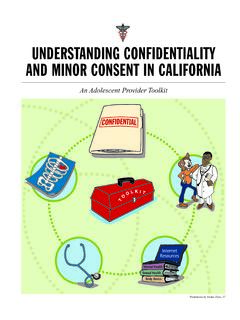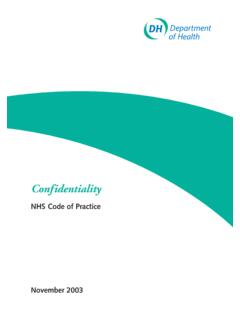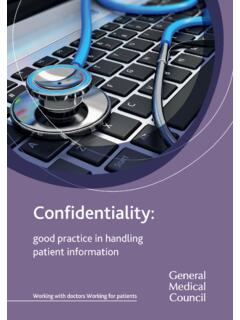Transcription of Confidentiality: NHS Code of Practice - GOV.UK
1 1 confidentiality : NHS code of Practice Supplementary Guidance: Public Interest Disclosures November 2010 1 Supplementary Guidance: Public Interest Disclosures 2DH information READER BOXP olicyEstatesHR / WorkforceCommissioningManagementIM & TPlanning / FinanceClinicalSocial Care / Partnership WorkingDocument PurposeGateway ReferenceTitleAuthorPublication DateTarget AudienceCirculation ListDescriptionCross RefSuperseded DocsAction RequiredTimingContact DetailsLeedsGuidance to support the confidentiality : NHS code of Practice . The guidance is aimed at aiding decisions about disclosures of information in the public Informatics26 Nov 2010 medical Directors, Directors of Nursing, Local Authority CEs, Directors of Adult SSs, Directors of HR, Allied Health Professionals, GPs, Communications Leads, Emergency Care Leads, Directors of Children's SSs#VALUE!
2 confidentiality : NHS code of InformationFor Recipient's UseSuplementary Guidance: Public Interest DisclosuresLS2 7UE0113 3974498 David MartinDH InformaticsQuarry House Crown copyright 2010 First published November 2010 Published to DH website, in electronic PDF format only. Supplementary Guidance: Public Interest Disclosures 3 confidentiality : NHS code of Practice Supplementary Guidance: Public Interest Disclosures November 2010 Prepared by DH Policy and Planning Directorate (first edition) Supplementary Guidance: Public Interest Disclosures 4 Contents Executive summary .. 5 Introduction.. 6 7 Notes on Flowchart .. 8 Appendix 1: Public Interest Exemplar Cases .. 13 5 Executive summary This document expands upon the principles set out with the Department of Health s key guidance confidentiality : NHS code of Practice . The document is aimed at aiding staff in making difficult decisions about when disclosures of confidential information may be justified in the public interest.
3 Supplementary Guidance: Public Interest Disclosures 6 Introduction 1. This document extends the guidance on disclosure of confidential information in the public interest that is contained within Annex B of the Department of Health s confidentiality : NHS code of Practice1. Its purpose is to assist NHS staff in making what are often difficult decisions on whether a breach of patient confidentiality can be justified in the public interest.. 2. Decisions about disclosures of confidentially sensitive information must be made on a case-by-case basis. In considering whether to disclose information staff should consider the merits of each case however, certain considerations will need to be taken in all cases: Extent of the information which is to be disclosed it will be easier to justify disclosure of demographic data or the fact that someone attended a clinic rather than detailed health information .
4 The nature and impact of the crime or harm justifying the disclosure - it will be easier to justify disclosure of information relating to a physical attack against a person than it would be for shoplifting. Whether the disclosure is for detection or prosecution of crime or harm to others or whether it is preventative - it may be more justifiable to disclose information to support prosecution in relation to a crime that has occurred than to prevent a crime which has not yet occurred. 3. A public interest justification for disclosure can be considered, and this guide becomes useful, in situations where: Disclosure would be in the public interest2; AND The purpose of the disclosure cannot be achieved with anonymised information ; AND There is no statutory basis for disclosure3; AND Patient consent4 has not been given because: o It is not practicable to ask the patient(s) for consent because, for example, there are no up-to-date contact details for the patient, or the matter is urgent and the patient cannot be contacted; OR o It would be inappropriate to ask the patient(s) because, for example, they lack the capacity to give consent, or they are suspect(s) who should not be informed that they are under criminal investigation; OR o The patient(s) have been asked for consent and refused.
5 1 Available at 2 Disclosure of the information must result in public benefit; this is not the same as something being of interest to the public ( a scandal). 3 Note that this guidance does cover the Public Interest Disclosure Act 4 Or those empowered to make decisions on behalf of the patient, which for an incompetent child is a person with parental responsibility, and for an adult lacking capacity it is someone empowered to make decisions under the Mental Capacity Act 2005 (see in particular paragraph 3 of the Act available at: #pt1-pb2-l1g3). Supplementary Guidance: Public Interest Disclosures 7 When might disclosure of confidential patient information without consent be justified in the public interest? This flowchart contains decisions (diamonds) and actions (rectangles) describing the logic that can be followed when making public interest judgements.
6 Where these decisions and actions merit further explanation, they are numbered and notes follow. Supplementary Guidance: Public Interest Disclosures 8 Notes on Flowchart 4. Gather relevant information It is important to begin by gathering relevant information to inform the public interest judgement to be made, such as: The purpose(s) served by the disclosure, and whether the purpose(s) could be served without the disclosure of confidential patient information ; The individual(s) and/or organisation(s) affected by disclosure or non-disclosure, and the resulting level of detriment or benefit; The confidential information that is requested or required; The proposed recipient(s) of the disclosure, and whether they will disclose the information further; Whether there is either a statutory barrier or requirement to disclose; Who should be involved in the decision and who will be accountable; and The urgency of the decision.
7 5. The patient should be asked to consent to the disclosure (thus avoiding the need for public interest override) and/or for their perspective on the impact of disclosure (which can be helpful when weighing up whether to disclose), unless it is impractical to do so, or when contacting the patient would undermine the purpose of the disclosure. 6. Is disclosure justifiable under the DPA? Where confidential information is being disclosed for a purpose other than those identified as medical purposes in schedule 3 of the Data Protection Act 1998 then another justification must be found for the processing . In Practice , it will be very rare that such a justification will not be available as functions of a public nature exercised in the public interest is itself a schedule 3 justification, as are administration of justice and vital interests (matters of life and death).
8 7. Is the disclosure necessary to prevent serious harm? It is important to distinguish between serious harm to the individual to whom information relates and serious harm to others. Confidential information can be disclosed without consent to prevent serious harm or death to others. This is likely to be defensible in common law in the public interest. 8. Where the patient is an adult lacking capacity, the Mental Capacity Act applies, and the best interests of the patient concerned can be sufficient to justify disclosure, information can be disclosed to prevent a patient who lacks capacity from being harmed. 9. However, an individual s best interests are not sufficient to justify disclosure of confidential information where he/she has the capacity to decide for him/herself. There has to be an additional public interest justification, which may or may not be in the patient s best interests.
9 Supplementary Guidance: Public Interest Disclosures 910. In some circumstance, where parents refuse to permit disclosure of information about a child who lacks capacity, clinicians should ultimately act in the best interest of the child. 11. Examples of where public interest can be a defence include: Reporting to the Driver & Vehicle Licensing Centre a patient who rejects medical advice not to drive (although health professionals should inform the patient of their intention to report it); Breaching the confidentiality of a patient who refuses to inform his or her sexual partner of a serious sexually transmissible infection; Releasing relevant confidential information to social services where there is a risk of significant harm to a child. 12. Is disclosure necessary to prevent, detect or prosecute serious crime? Confidential patient information can be disclosed in the public interest where that information can be used to prevent, detect, or prosecute, a serious crime.
10 Serious crime is not clearly defined in law but will include crimes that cause serious physical or psychological harm to individuals. This will certainly include murder, manslaughter, rape, treason, kidnapping, and child abuse or neglect causing significant harm and will likely include other crimes which carry a five-year minimum prison sentence but may also include other acts that have a high impact on the victim. 13. On the other hand, theft, fraud or damage to property where loss or damage is not substantial are less likely to constitute a serious crime and as such may not warrant breach of confidential information , though proportionality is important here. It may, for example, be possible to disclose some information about an individual s involvement in crime without disclosing any clinical information . 14. In the grey area between these two extremes a judgement is required to assess whether the crime is sufficiently serious to warrant disclosure.















